|
A Look at the Wintry World Inside
by Bob Brooke
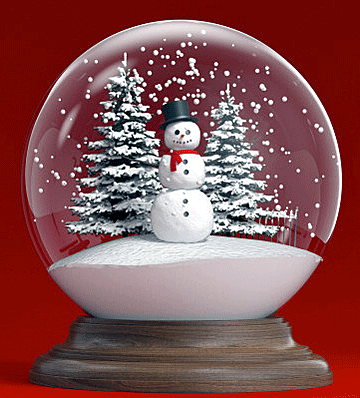 Collectors
love snow globes. Some call them water balls, shake toys or snow
domes. Others call them blizzard weights, crystal-shakes,
Schneekugel or “snow ball,” snowfall weights, snowscenes, snowshakes,
snowstorms, water globes, or water-filled weights. Among American
collectors, snow globe and snow dome are the two most popular names.
But snow globes aren’t always round. Many come in a variety of
shapes like bottles, cubes, drums and rectangles. Whatever they’re
called, they’re winter wonderlands that mesmerize both adults and
children. Collectors
love snow globes. Some call them water balls, shake toys or snow
domes. Others call them blizzard weights, crystal-shakes,
Schneekugel or “snow ball,” snowfall weights, snowscenes, snowshakes,
snowstorms, water globes, or water-filled weights. Among American
collectors, snow globe and snow dome are the two most popular names.
But snow globes aren’t always round. Many come in a variety of
shapes like bottles, cubes, drums and rectangles. Whatever they’re
called, they’re winter wonderlands that mesmerize both adults and
children.
Snow Globe Beginnings
Snow globes originated in France in the 1870s.
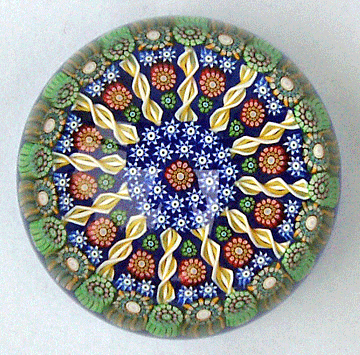 Extensions
of the solid-glass paperweights, some of the earliest ones contained
patterns and shapes and soon someone came up with the idea of
putting liquid and white powder inside them. By 1878, there were at
least seven French manufacturers exhibiting them at the
Exposition Universelle, or “Exhibition of the Works of Art and
Industry of All Nations,” held in Paris between May 1 and October
10. The most common one was a globe containing a man with an
umbrella. When a person turned the paperweight upside down, the
white powder in the globe floated down like snow. Extensions
of the solid-glass paperweights, some of the earliest ones contained
patterns and shapes and soon someone came up with the idea of
putting liquid and white powder inside them. By 1878, there were at
least seven French manufacturers exhibiting them at the
Exposition Universelle, or “Exhibition of the Works of Art and
Industry of All Nations,” held in Paris between May 1 and October
10. The most common one was a globe containing a man with an
umbrella. When a person turned the paperweight upside down, the
white powder in the globe floated down like snow.
Even the use of the term "snow" is questionable. Contemporary snow
globes often contain “flitter,” the technical name for the floating
material in the form of porcelain flecks, bone chips, camphor and
wax, ground rice, iridescent glitter or plastic geometric or figural
pieces like tiny dollar bills or black bats for Halloween, rather
than white snow. Theme related flitter is becoming more and more
common.
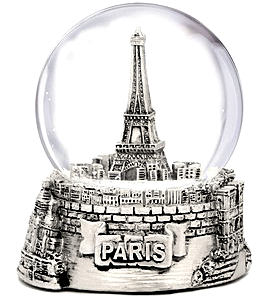 In
1889, an unknown company produced a snow globe containing a model of
the newly built Eiffel Tower was produced to commemorate the
International Exposition in Paris, which marked the centenary of the
French Revolution. Snow globes became popular in England during the
Victorian Era and, in the early 1920s, crossed the Atlantic to the
United States where they became a popular collectors’ item. In
1889, an unknown company produced a snow globe containing a model of
the newly built Eiffel Tower was produced to commemorate the
International Exposition in Paris, which marked the centenary of the
French Revolution. Snow globes became popular in England during the
Victorian Era and, in the early 1920s, crossed the Atlantic to the
United States where they became a popular collectors’ item.
At the end of the 19th century Austrian Erwin Perzy, a producer of
surgical instruments, invented the so-called Schneekugel, or
snow globe, and got the first patent for it. Originally he wanted to
develop an extra bright light source for use as a surgical lamp. As
he tried to intensify the candlepower of a so-called
Schusterkugel, a water filled flask used to
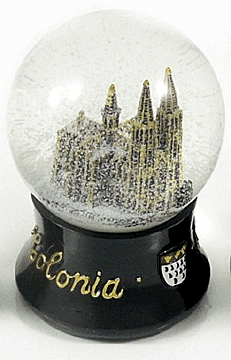 focus
light since the Middle Ages, with particles made out of different
materials for better reflection, the effect reminded him of a
snowfall, and thus he got the idea for a snow globe. He then built
his first actual globe and placed a model of the Basilica of
Mariazell in it. Because of the great request for his snow globes,
Perzy, along with his brother Ludwig, opened a shop in Vienna, where
production continues today. The material the firm uses to produce
the "snow" is a closely guarded secret that has been handed down
from generation to generation. focus
light since the Middle Ages, with particles made out of different
materials for better reflection, the effect reminded him of a
snowfall, and thus he got the idea for a snow globe. He then built
his first actual globe and placed a model of the Basilica of
Mariazell in it. Because of the great request for his snow globes,
Perzy, along with his brother Ludwig, opened a shop in Vienna, where
production continues today. The material the firm uses to produce
the "snow" is a closely guarded secret that has been handed down
from generation to generation.
Because the globes had to be hand blown, the glass-making centers of
Germany, present-day Austria and the Czech Republic became the
principal manufacturing centers.
Snow Globes Beyond Europe
Snow globes initially came to the U.S. as souvenirs purchased by
Americans traveling abroad. By the early 20th century, cottage
industry manufacturers in Austria, Czechoslovakia, France, the
Bavaria region of Germany and Poland made snow globes for European
tourist sites. Few of these early snow globes contained a
manufacturer’s mark.
Joseph Garaja of Pittsburgh developed the first American snow globe.
His patent, granted Dec. 31, 1929, focused on ball paperweights with
movable features, for instance, a fish among a bed of sea plants.
While the patent makes no mention of snow, Johnson Smith and Co., a
seller of mail-order novelties, offered one with a miniature snowman
with snowflakes blowing about him.
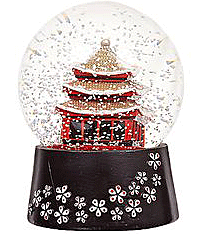 The success of the European and American snow globes attracted the
attention of the Japanese. Japanese manufactured snow globes began
arriving in the United States in the late 1930s. Asian manufacturers
from Japan and Hong Kong quickly dominated the market. Flexibility
in form and an endless variety of motifs contributed to their
success. But there was a flaw. Many Asian snow globes featured
pirated designs from European makers, as well as shoddy
construction. The success of the European and American snow globes attracted the
attention of the Japanese. Japanese manufactured snow globes began
arriving in the United States in the late 1930s. Asian manufacturers
from Japan and Hong Kong quickly dominated the market. Flexibility
in form and an endless variety of motifs contributed to their
success. But there was a flaw. Many Asian snow globes featured
pirated designs from European makers, as well as shoddy
construction.
When World War II interrupted Japanese imports, William M. Snyder
founded Atlas Crystal Works of Trenton, New Jersey, and built it
into a snow globe manufacturing empire during the 1940s, aided in
part by a government contract to supply snow globes for sale in
military stores during the war.
Contents of Snow Globes
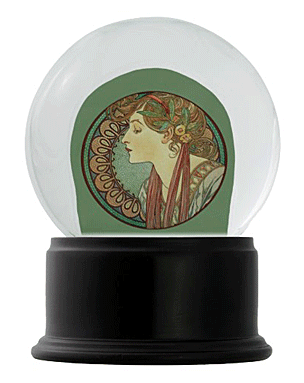 Initially snow globes consisted of a heavy lead glass globe placed
over a ceramic figure or tableau on a black cast ceramic base,
filled with water and then sealed. Manufacturers used bone chips or
pieces of porcelain, sand or even sawdust for the snow or “flitter.”
As they became more sophisticated, the glass became thinner, the
bases lighter. During the Art Deco period, bakelite was popular, and
the snow in these globes consisted of particles of gold foil or
non-soluble soap flakes. Initially snow globes consisted of a heavy lead glass globe placed
over a ceramic figure or tableau on a black cast ceramic base,
filled with water and then sealed. Manufacturers used bone chips or
pieces of porcelain, sand or even sawdust for the snow or “flitter.”
As they became more sophisticated, the glass became thinner, the
bases lighter. During the Art Deco period, bakelite was popular, and
the snow in these globes consisted of particles of gold foil or
non-soluble soap flakes.
And while manufacturers originally filled them with water, many
today use glycol, an antifreeze and thickening agent, that helps
keep the flitter afloat. An added benefit was that glycol slowed the
descent of the snow. Though the figures inside are very small,
they’re magnified by the liquid.
Collecting Snow Globes
 Winter or Christmas themes dominate snow globes. But there are ones
that celebrate other holidays, seasons, and special occasions like
birthdays and weddings. There are even snow globes that show
likenesses of such celebrities as James Dean, Marilyn Monroe, or
Elvis Presley. Winter or Christmas themes dominate snow globes. But there are ones
that celebrate other holidays, seasons, and special occasions like
birthdays and weddings. There are even snow globes that show
likenesses of such celebrities as James Dean, Marilyn Monroe, or
Elvis Presley.
Victorian loved filling their homes with knickknacks, treasured
souvenirs, and sometimes simply kitschy things like snow globes.
They were great conversation pieces then as now.
Snow globe collecting increased threefold in 1940 when RKO Radio
Pictures Inc. released Kitty Foyle: The Natural History of a Woman,”
starring Ginger Rogers. A snow globe with a bisque figure of a young
girl sledding down a hill from a castle serves as the transition
element between principal scenes.
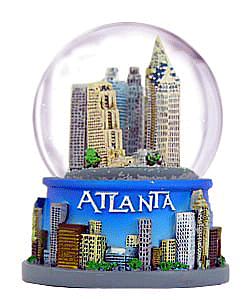 Although snow globes became passé in the late 1940s, the form
remained alive. The snow globe was in transition. When it emerged in
the late 1950s, it was a very different product from the traditional
glass ball globe on a ceramic or plastic base. Thermo-plastic
injection molding, developed during and immediately after World War
II, allowed snow globes to be made with plastic globe-shaped forms
with injected molded interior scenes. Although snow globes became passé in the late 1940s, the form
remained alive. The snow globe was in transition. When it emerged in
the late 1950s, it was a very different product from the traditional
glass ball globe on a ceramic or plastic base. Thermo-plastic
injection molding, developed during and immediately after World War
II, allowed snow globes to be made with plastic globe-shaped forms
with injected molded interior scenes.
The snow globe renaissance that began in the late 1950s continued
through the 1960s. With the advent of microelectronics, many snow
globes were no longer mere paperweights but featured lights, motion
and music.
Once again, the excitement wore off. As the cost of production rose
during the 1970s and early 1980s, many souvenir snow globes
disappeared. Fortunately, the seasonal holiday gift market has kept
snow globes alive.
<
Back to More Antique Spotlights
Next Article > |
